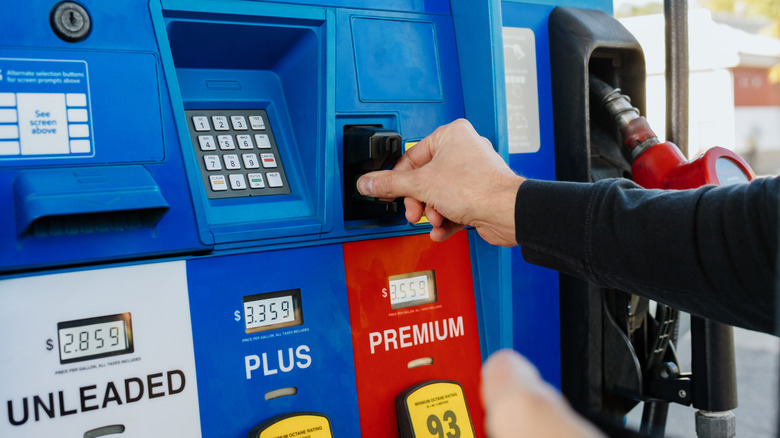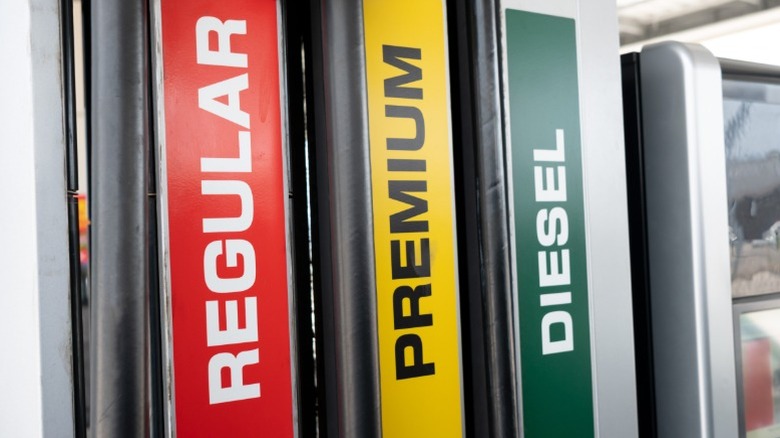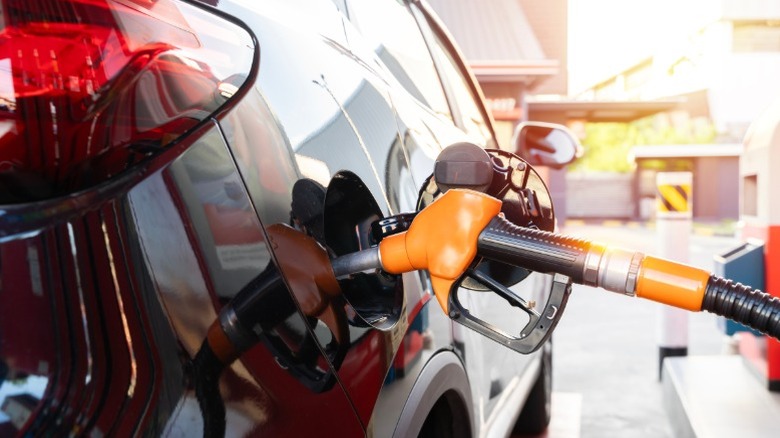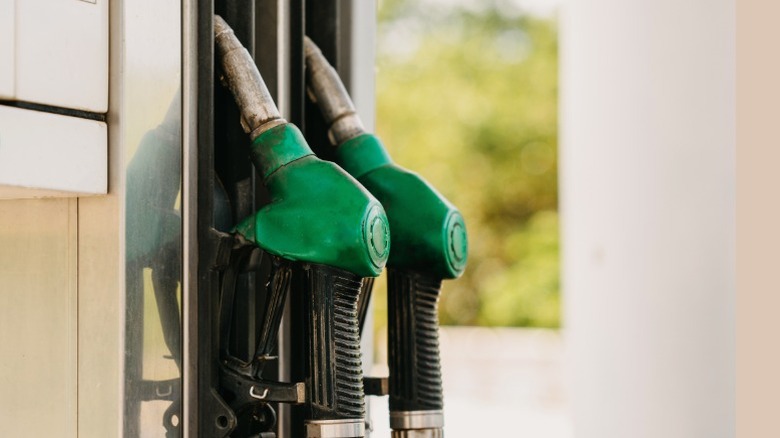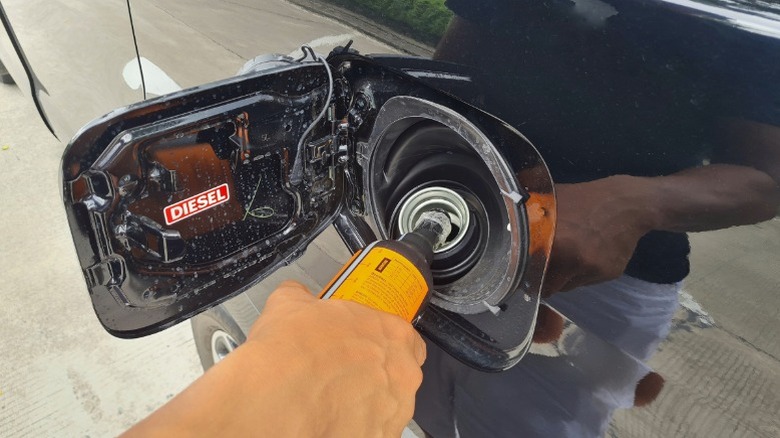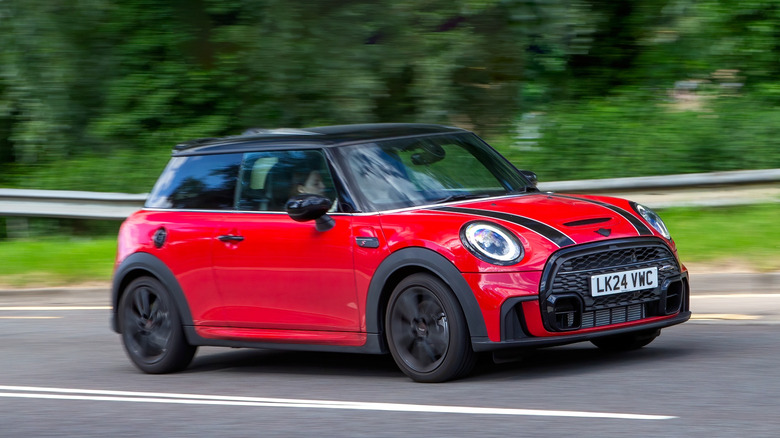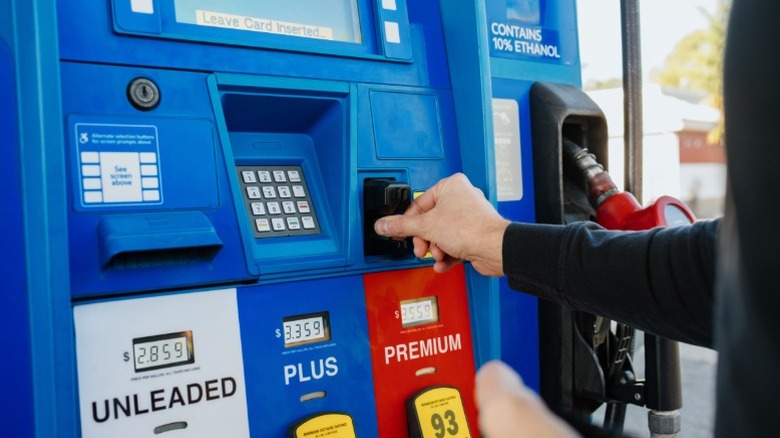9 Fuel Myths You Really Should Stop Believing
You're running late, the fuel gauge is dangerously low, and you're convinced that turning off the air conditioning and rolling down the windows will stretch those last few drops of gas enough to get you where you're going. We've all heard little tips like this, maybe through a friend, mechanic, or even on some car forum thread.
Since most cars use fuel, it's no surprise that drivers are always looking for ways to cut down on fuel costs or modding cars for better fuel economy. And there's no shortage of fuel tips out there, be it from family, friends, or the internet. But it won't take long before you run into some questionable advice.
You see, not all of these tips are grounded in fact, and many do little more than waste your time or add inconvenience to your life. To help separate fact from fiction, we've identified nine fuel myths you really should stop believing.
Using premium fuel will improve your car's performance
You've probably been faced with the dilemma of choosing between regular fuel and premium fuel at the gas station. It's easy to believe that the higher price and the premium tag mean that the fuel is cleaner or adds some benefits to your car, like improved performance and power. But that's not entirely true.
To start with, the key difference between regular fuel and premium fuel is that the latter has a higher octane rating. Octane rating refers to the level of heat resistance of fuel without causing engine knocking. So, premium fuel can benefit your car, but only when the manufacturer recommends it.
For instance, some luxury, sport, or other high-performance vehicles require premium fuel due to the use of superchargers, turbochargers, or high-compression engines. However, buying premium fuel for a regular car is simply a waste of money as there's no significant benefit.
So, how do you know if your car needs premium fuel? In most cases, you can check the door of the fuel filler or owner's manual to see the minimum octane rating your engine needs. According to the U.S. Department of Energy, an octane rating between 91 and 94 is considered premium.
Keeping your windows open is always fuel-efficient
It's true that having your car's air conditioning on can affect your fuel usage, so it's common for people to believe that having their car windows down is a sure way to conserve fuel on the road. This issue has become such a debate that studies have been conducted to determine what car owners should really do to get the most out of their fuel.
The science behind this is less straightforward than you might think. Your AC uses engine power to operate, and this extra strain requires and uses up more fuel. This is backed by a U.S. Department of Energy report, which states that using your air conditioning, especially during short trips, can reduce fuel economy by up to 25%.
On the other hand, when your windows are down, there's increased wind resistance, also known as aerodynamic drag. In simple terms, as air moves through your vehicle, it creates a force that resists its motion, thus slowing it down. Aerodynamic drag increases with a number of factors, including speed. So, when you have your windows down and moving at high speed, you're using up more fuel.
So, while you're on the highway or moving at a consistently high speed, turning on your AC can actually be more fuel-efficient than having your windows down. However, bear in mind that other factors, such as car design, can also impact fuel efficiency.
Your fuel tank will explode if you fill it up in hot weather
So you've heard about soda cans and deodorants exploding due to high heat in the summer, and perhaps a thing or two about your fuel tank being susceptible to this same risk. This rumor has been around for quite some time, and if you're still skeptical about whether your filled-up tank is truly a risk, the short answer is no.
The explanation is simple. Cars are designed to cope with various weather conditions, and that includes heat. So, your fuel system is pretty capable of handling a heatwave. This fear often stems from the misconception that the heat is capable of causing the fuel to self-ignite. According to Snopes, in order to combust without a trigger, fuel has to reach 495º F, a figure that an insulated tank is extremely unlikely to reach.
The other assumption, which is based on the idea that a build-up of pressure will induce an explosion, is also unfounded. Fuel systems have been designed to control pressure, formerly with the use of vented gas caps and, more recently, through Evaporative Emission Control (EVAP) systems, which is a requirement in the U.S.
Manual transmissions have better fuel economy than automatic ones
For some car enthusiasts, especially sports car lovers, the manual transmission will never lose its appeal. Despite automatic transmission cars now dominating the road, they tend to be costlier to maintain than their manual counterparts and, to some people, less cool. Once upon a time, they also brought better fuel economy to the table, but that's hardly the case anymore.
A few things gave the manual car an edge in fuel economy. For instance, in the past, automatic cars generally came with three to four gears, while manual cars tended to have five to six gears. This, coupled with the advantage of greater control over gear selection, allowed manual cars to maintain low RPMs at higher speeds, thereby conserving fuel. There was also the torque converter in automatic cars, which contributed to low efficiency.
Today, many modern automatics run on more gears, with seven-, eight-, and nine-speed automatics available on various models. Innovations like single-automated clutches and dual-automated clutches on these vehicles further close the gap in fuel economy, so that we have automatic cars that perform just as well, if not better, than their manual counterparts in terms of fuel economy.
Idling is more fuel efficient than restarting
When stopping your car briefly due to traffic or at a stoplight, should you turn your engine off and restart, or is idling more fuel efficient? Many car owners tend to think the latter option is better; After all, starting a car should consume more energy. However, in reality, stopping and starting is actually a better way to conserve fuel.
Research by Argonne National Laboratory tested this debate, the results of which determined that you only need to idle for more than 10 seconds before the impact surpasses that of restarting your vehicle. It also determined that starting and stopping is the better option for minimizing CO2 emissions.
The idea that starting and stopping is less fuel efficient is not entirely unfounded. When carburetors were used, idling consumed less fuel. However, fuel injection has greatly improved fuel and energy conservation, so you don't burn as much fuel when starting your vehicle. Modern cars even come with an auto stop-start feature, a technology that temporarily turns off the engine when the car comes to a stop and starts it when the driver accelerates or releases the brake.
Refueling in the morning gives you more fuel mileage
There's a theory that when you purchase fuel in the morning or at night, you actually get more fuel than usual and more mileage out of your vehicle. If you've heard this before, you might have also found the reasoning compelling. The idea is that fuel is denser when cold and expands when heated. So, filling up your tank before or after the sun is out will give you a greater quantity of fuel than otherwise.
While it is true that fuel gets denser in cooler temperatures, you're not getting much benefit from timing your purchase due to how fuel is stored. In most countries, including the U.S., gasoline and diesel fuel are stored in underground tanks. These tanks are heavily insulated, ensuring that the fuel retains a consistent temperature throughout the day. Even if any temperature changes occur, it is not high enough to increase the volume of fuel significantly.
Also, when fuel gets to the pump, the large shade at the fuel station reduces how much heat gets to the fuel. In short, even if you're somehow able to save a few cents, going out of your way to fill your tank would likely cost you more.
Fuel additives will transform your car's engine
Fuel additives are sometimes marketed as magic potions that will dramatically improve engine performance or boost gas mileage significantly. In reality, these products do offer benefits to your vehicle, but probably not as much as you think.
To start with, you should understand what these products are. Fuel additives are chemical substances designed to enhance fuel quality and vehicle performance. These products, usually in liquid form, are mixed with fuel and are able to modify its properties and improve its quality in different ways.
Depending on the type, fuel additives claim to boost octane ratings, clean the fuel injector by removing contaminants, prevent corrosion in the fuel system, or add to fuel shelf life. Whether they actually work largely boils down to the type of fuel additive, the brand, and your vehicle's needs. In most cases, as long as you're buying quality fuel and carrying out regular maintenance, you don't need any additives. In any case, their use is limited, and they can't fix any mechanical defects or transform your vehicle.
Smaller cars always have better fuel mileage
If you think getting a small car is going to help you save some fuel costs, as opposed to a bigger car, we hate to break it to you, but that might not be the case. The reasoning here is that smaller engines usually equal less fuel consumption. Truly, many powerful cars that have graced the road have been fitted with large engines that have drained fuel generously. But with advancements in technology, a lot has changed, thanks to innovations like direct fuel injection, forced induction, and high compression.
Moreover, even when smaller engines are advertised to burn less fuel than their larger counterparts, when performing actual on-road tasks, a smaller engine can end up consuming more fuel. For instance, a 2014 U.K. study found that cars that had smaller engines ended up burning more fuel than the advertised rate because they accelerated more and traveled at higher speeds than during the official testing. Thus, when a car is fully loaded or moving at high speed, a larger engine is likely to handle the extra work better. More importantly, an adequate fuel-to-weight ratio ensures that the engine is not overworked or producing more power than required.
Fuel has no shelf life
If you have some leftover fuel that has been stored around for months or a vehicle you haven't driven in a while, you might wonder if the fuel is still in perfect condition. It's easy to think fuel would last a lifetime since crude oil takes millions of years to form. Well, it doesn't. The refining process involves a lot of changes to crude oil so that by the time it gets to the fuel station, it's well-suited for your car engine and other products.
Over time, the chemicals in fuel break down, and their properties change. This is influenced by environmental factors like oxygen, humidity, and heat, so there's no strict rule on how long your gas will last before it starts to degenerate. Generally, if fuel is stored in your tank, it has about a month before it begins to go bad. However, when stored properly in containers, it can last from about 3 to 6 months. Premium fuel, on the other hand, is known to have a higher life span and can retain its quality for about 9 months.
You can identify bad fuel from the way it looks and smells. However, the way your car behaves may also be an indicator. For instance, if it refuses to start or stalls unexpectedly, it can be a sign you've got some bad fuel in the tank.
